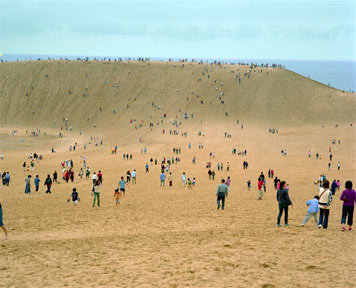Hiromi Tsuchida
dal 24/1/2008 al 28/3/2008
Segnalato da
24/1/2008
Hiromi Tsuchida
Michael Dawson Gallery, Los Angeles
Photographs, 1969-2004. This solo show explains the artist's intention to examine the central quality of Japanese life and culture. He analyzes the distance within crowds and the clash between tradition and modernity that structures Japanese society.

“The more one tries to see, the further it hides away. What one begins to see instead is one’s vulgar desire to look... I decided to remain there for a while in order to watch the process of how the profane that moves around the walls interacts with and relates to the sacred site... how does the sacred site remain sacred for so long? The reason can be found in nothing but the profane desires themselves that filled the sacred site.”
-- Tsuchida, from Report note, Sacred Sites of Japan.
Michael Dawson Gallery is pleased to present the first solo exhibition in Los Angeles of photographs by Hiromi Tsuchida. The text quoted above describes the central motif of the artist’s work. By replacing the words “sacred site” with “Japan,” we begin to see Tsuchida’s intention to examine the central quality of Japanese life and culture.
Born in Fukui Prefecture in 1939, Tsuchida studied engineering before enrolling in the Tokyo College of Photography in 1965 where he was later to return as a professor. He became a freelance photographer in 1971 and began receiving recognition for his work early in his career; he was included in the 1974 “New Japanese Photography” exhibition at the Museum of Modern Art in New York.
For this exhibition, Michael Dawson Gallery will focus on three of Tsuchida’s major projects: Zokushin, 1969-1975, Counting Grains of Sand, 1975-1989, and New Counting Grains of Sand, 1990-2004. Zokushin, Tsuchida’s first publication and perhaps his best known work, was produced during the early 1970s. Tsuchida traveled through rural areas across Japan to photograph people in their daily lives. He used the term Zokushin, which translates as “Gods of the Earth,” to refer to people who live simply, spontaneously, little concerned with what others think or how they themselves look or dress – the “ordinary” people of Japan. The series explores their relationship with traditional festivals, rituals, and particularly with spirituality and religion.
Tsuchida further developed his study of the Japanese people with his series, Counting Grains of Sand, which he began in 1975. The series explores how the Japanese people interact and function in a crowd, with each person a “grain of sand.” Tsuchida decided to stop working on the series in 1989, when the “the crowd to end all crowds” came to mourn the death of Emperor Hirohito. However, during the 1990s he began to work on the series again, under the title, New Counting Grains of Sand, as he was struck by the shifting dynamic of the crowd in today’s Japan. Crowds are no longer seas of people but have become networks of small groups, maintaining a certain distance from each other. For this series, Tsuchida’s artwork changed from smaller black and white photographs to large scale color photographs.
Tsuchida attempts to express the changes in Japanese culture and society through his work, analyzing the distance within crowds and the clash between tradition and modernity that structures Japanese society. It has been said that his work highlights the unification brought about by the sacred and the profane within the context of a society with this dual structure. Doing so he captures a universal element that exists outside of time and indifferent to western influences.
Tsuchida’s work has been featured in exhibitions around the world including “Japan: A Self-Portrait at the International Center of Photography in New York,” (1979) “Photography Now at the Victoria & Albert Museum,” (1989) and “Japon 1945-1975: Un Renouveau Photographique” at the Patrimoine Photographique, Hôtel de Sully in Paris (2003). Tsuchida lives and works in Tokyo.
Opening reception: Friday, January 25, 7pm - 9pm
Image: Hiromi Tsuchida, “Tottori”, 2001. Courtesy Studio Equis.
Michael Dawson Gallery
535 North Larchmont Boulevard - Los Angeles



